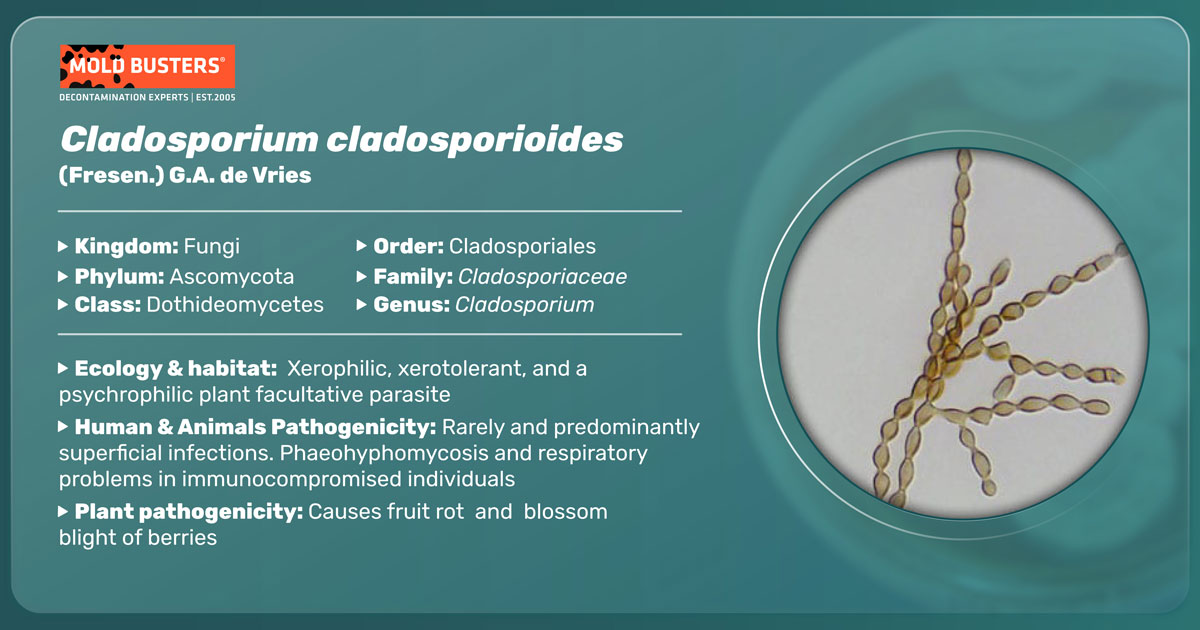(Fresen.) G.A. de Vries
Cladosporium cladosporioides belongs to the cosmopolitan genus Cladosporium, which encompasses more than 700 species of fungi (1,2). Cladosporium sp. are commonly found on many kinds of plant and fungal debris. They can be isolated from soil, food, paint and textiles, and various other organic matter. C. cladosporioides is among several Cladosporium plurivorous species, while the majority of species from this genera are somewhat specialized (2).

Cladosporium sp. can also infect plants as secondary invaders and thus be isolated from leaf lesions caused by the pathogenic fungi. In some cases, C. cladosporioides can also be pathogenic in humans (3–5). Furthermore, some Cladosporium species are common endophytes (being able to live inside a plant without causing harm), and yet other are known hyperparasites (they parasites of parasitic fungi) (6). Cladosporium sp. are also one of the more frequent fungi found in refrigerators (7).
What is Cladosporium cladosporioides?
Cladosporium cladosporioides is an asexual, widespread mold that occurs on a wide range of outdoors and indoor surfaces and materials. It is a frequent saprophyte and is a common agent of secondary infections of dying parts of plants. C. cladosporioides is one of the most frequent (outdoor) airborne fungi but is also very common indoors, growing on moist building materials, paint, wallpaper, textiles, tiles, and wet window sills. It infects economically important crops such as strawberries, and in rare, causes infections in humans (8,9).
Cladosporium cladosporioides ecology
Cladosporium cladosporioides is xerophilic, xerotolerant, and a psychrophilic organism. This means that it is tolerant to both dry and cold conditions (10). It can grow at freezing temperatures, and its enzymes can remain active at temperatures between -10°C and -3°C (14°F and 26.6°F). All these capabilities are likely the reason why C. cladosporioides has such a wide cosmopolitan range. Even though the species grows all almost throughout the year, it achieves peak sporulation in the summer (11). It commonly occurs as a secondary infection on necrotic parts of many different host plants. Its spores can be isolated from air, soil, textiles, and many other substrates (2).
Cladosporium cladosporioides morphology and cultivation
In general, C. cladosporioides colonies appear velvety or powdery and are olive-green to olive-brown. Colony morphology will vary depending on the growth media (12). Cultivating on the potato dextrose agar medium (PDA), the colonies will appear as olive-grey to dull green, velvety, tufted, and feathery on the edges. On PDA, C. cladosporioides diffuses to the media and rarely grows above the surface, only occasionally forming prominent hyphal exudates (12). Colonies on malt extract agar (MEA) medium grow pale olive-grey or whitish due to aerial mycelium but form darker edges.
The species is asexual and forms only vegetative spores (conidia). Conidia are numerous, forming on terminal branches (often up to ten conidia per branch). They are smaller in size (4-8 μm long, 2-4 μm wide), single-celled, oval-shaped, and smooth-walled. C. cladosporioides optimally grow between 20 °C and 25 °C (68° to 77°F) and requires the media water activity (Aw) of between 0.85 and 0.88 (2,10,12).
Cladosporium cladosporioides as a plant pathogen
The species is most known as one of the agents of Cladosporium fruit rot of red wine grapevines and strawberry blossom blight. Moreover, C. cladosporioides is also known to infect crops such as wheat, peas, blackberry, raspberry, and spinach. Generally, the fungus causes little actual damage to the infected fruit. However, because the mycelial growth is unappealing, the fruit becomes unmarketable (13).
The incidence of the Cladosporium red wine rot infection is higher when the harvest of the grapes is delayed. The delaying of the grape harvest is necessary as the grapes need to fully ripen so that the various phenolic compounds can contribute to the aroma and flavor of the fruit, and consequently, to the vine. This disease is well-known to attack the Cabernet Sauvignon vineyards of South America (14). Symptoms of the disease are most pronounced on fully matured grapes and are displayed as dehydration, olive-green mold cover, and a small, firm area of decay. Unfortunately, the practice of leaf removal works well against most other fungi; as it decreases the inoculate pressure; however, it has been shown that in the case of grapevine rot to be counter-indicated. The only solution to the disease is to shorten the sun exposure time of the plants and hasten the grape harvest.
Cladosporium cladosporioides as a human and an animal pathogen
Cladosporium cladosporioides can cause human mycotic infections, although rare and predominantly concerning superficial infection cases (3–5). However, several systemic problems such as phaeohyphomycosis, respiratory inflammation, or asthmatic and allergic reactions have been recorded. Due to certain compounds, such as beta-glucans and other allergens, present on the surface of spores, C. cladosporioides can trigger asthmatic reactions (15). Interestingly, in one case report, C. cladosporioides was isolated from cerebrospinal fluid and a brain biopsy specimen of a human patient, which was severely immunocompromised (8).
It was shown that in rats, spores of C. cladosporioides can stimulate alveolar macrophages to produce macrophage inflammatory proteins and keratinocyte chemoattractant, thereby inducing respiratory inflammation and diseases such as allergic alveolitis and atopic asthma (16). However, the severity of the response seems to be concentration-dependent. Moreover, one report described a German shepherd dog diagnosed with encephalitis and nephritis due to infection of C. cladosporioides. Further examination found brainstem and cerebellar lesions caused by the fungus, which were likely responsible for abnormal limb reflexes, altered behavior, depression, and loss of vision (17).

Did you know?
Only 11% of tested bedrooms in Canada didn’t have any mold type present?! Find out more exciting mold stats and facts on our mold statistics page.
Bibliography
- Dugan, F. M., Schubert, K., & Braun, U. (2004). Check-list of Cladosporium names. Schlechtendalia, 11, 1-103.
- Bensch, K., Braun, U., Groenewald, J. Z., & Crous, P. W. (2012). The genus cladosporium. Studies in mycology, 72, 1-401.
- Vieira, M. R., Milheiro, A., & Pacheco, F. A. (2001). Phaeohyphomycosis due to Cladosporium cladosporioides. Sabouraudia, 39(1), 135-137.
- Castro, A. S., Oliveira, A., & Lopes, V. (2013). Pulmonary phaeohyphomycosis: a challenge to the clinician. European Respiratory Review, 22(128), 187-188.
- Annessi, G., Cimitan, A., Zambruno, G., & Silverio, A. D. (1992). Cutaneous phaeohyphomycosis due to Cladosporium cladosporioides: Cladosporium cladosporioides als Erreger einer kutanen Phaeohyphomykose. Mycoses, 35(9‐10), 243-246.
- Heuchert, B., Braun, U., & Schubert, K. (2005). Morphotaxonomic revision of fungicolous Cladosporium species (hyphomycetes). Schlechtendalia, 13, 1-78.
- Altunatmaz, S. S., Issa, G., & Aydin, A. (2012). Detection of airborne psychrotrophic bacteria and fungi in food storage refrigerators. Brazilian Journal of Microbiology, 43(4), 1436-1443.
- Kantarcioǧlu, A. S., Yücel, A., & De Hoog, G. S. (2002). Case report. Isolation of Cladosporium cladosporioides from cerebrospinal fluid. Mycoses, 45(11‐12), 500-503.
- Koike, S. T., Vilchez, M. S., & Paulus, A. O. (2003). Fungal ecology of strawberry flower anthers and the saprobic role of Cladosporium cladosporioides in relation to fruit deformity problems. HortScience, 38(2), 246-250.
- Cladosporium cladosporioides | INSPQ [Internet]. [cited 2021 Jun 27]. Available from: inspq.qc.ca
- JD, Flannigan B. Robert AS Miller (2011). “Microorganisms in home and indoor work environments.” Diversity, health impact, investigation, and control.
- Bensh, K., Groenewald, J. Z., Starink-Willemse, M., Andersen, B., Sumerell, B. A., & Shin, H. D. (2010). Species and ecological diversity within the Cladosporium cladosporioides complex (Davidiellaceae, Capnodiales). Stud Mycol, 67(1), 1-94.
- UC IPM: UC Management Guidelines for Cladosporium Fruit Rot on Cranberries [Internet]. [cited 2021 Jun 27]. Available from: ipm.ucanr.edu
- Briceño, E. X., & Latorre, B. A. (2008). Characterization of Cladosporium rot in grapevines, a problem of growing importance in Chile. Plant disease, 92(12), 1635-1642.
- Mintz-Cole, R. A., Brandt, E. B., Bass, S. A., Gibson, A. M., Reponen, T., & Hershey, G. K. K. (2013). Surface availability of beta-glucans is critical determinant of host immune response to Cladosporium cladosporioides. Journal of allergy and clinical immunology, 132(1), 159-169.
- Shahan, T. A., Sorenson, W. G., Paulauskis, J. D., Morey, R., & Lewis, D. M. (1998). Concentration-and time-dependent upregulation and release of the cytokines MIP-2, KC, TNF, and MIP-1 α in rat alveolar macrophages by fungal spores implicated in airway inflammation. American journal of respiratory cell and molecular biology, 18(3), 435-440.
- Poutahidis, T., Angelopoulou, K., Karamanavi, E., Polizopoulou, Z. S., Doulberis, M., Latsari, M., & Kaldrymidou, E. (2009). Mycotic encephalitis and nephritis in a dog due to infection with Cladosporium cladosporioides. Journal of comparative pathology, 140(1), 59-63.
- Medmyco, author of Cladosporium cladosporioides photo. Available from: Wikipedia

Get Special Gift: Industry-Standard Mold Removal Guidelines
Download the industry-standard guidelines that Mold Busters use in their own mold removal services, including news, tips and special offers:

Written by:
Dusan Sadikovic
Mycologist – MSc, PhD
Mold Busters
Fact checked by:
Michael Golubev
General Manager
Mold Busters
